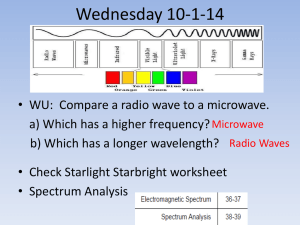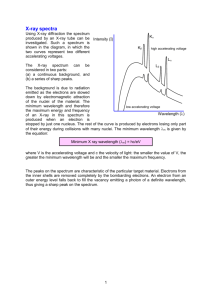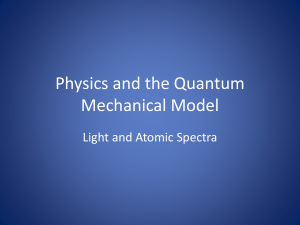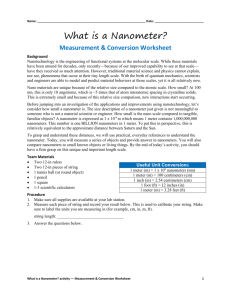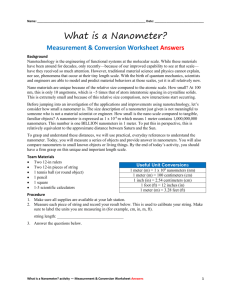Red Shift & Galaxy Motion: Spectrum Inquiry Lab
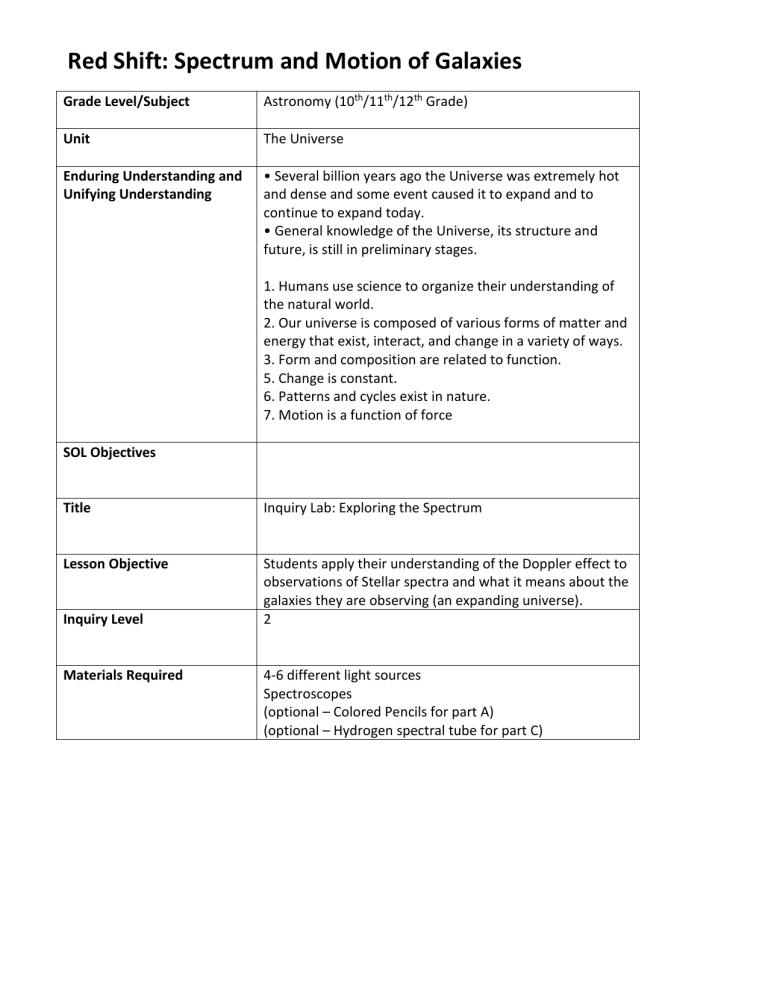
Red Shift: Spectrum and Motion of Galaxies
Astronomy (10 th /11 th /12 th Grade) Grade Level/Subject
Unit
Enduring Understanding and
Unifying Understanding
The Universe
• Several billion years ago the Universe was extremely hot and dense and some event caused it to expand and to continue to expand today.
• General knowledge of the Universe, its structure and future, is still in preliminary stages.
1. Humans use science to organize their understanding of the natural world.
2. Our universe is composed of various forms of matter and energy that exist, interact, and change in a variety of ways.
3. Form and composition are related to function.
5. Change is constant.
6. Patterns and cycles exist in nature.
7. Motion is a function of force
SOL Objectives
Title
Lesson Objective
Inquiry Level
Materials Required
Inquiry Lab: Exploring the Spectrum
Students apply their understanding of the Doppler effect to observations of Stellar spectra and what it means about the galaxies they are observing (an expanding universe).
2
4-6 different light sources
Spectroscopes
(optional – Colored Pencils for part A)
(optional – Hydrogen spectral tube for part C)
Name ______________________________________________ Period _____ Date _____________________________
Inquiry Lab: Exploring the Spectrum
Student Handout
Part A – Spectrum Observations
You will be exploring light in much the same way as the scientist do. An important part of scientific understanding comes from making and recording careful observations. This will be an important part of your scientific discovery and information gathered will be used throughout this activity. Using a spectroscope, look at as many light sources as you can find. When doing a spectral analysis of a light source, try to be as close to the light source as possible or darken the room. This prevents “contamination” from other light sources. Be sure to carefully color in the exact spectrum you see above the corresponding numbers (wavelengths of the light waves).
Start with looking at sunlight.
Light source:
400
Light source:
450 500 550 600
Wavelength in nanometers
650 700
400
Light source:
450 500 550 600
Wavelength in nanometers
650 700
400
Light source:
450 500 550 600
Wavelength in nanometers
650 700
400
Light source:
450 500 550 600
Wavelength in nanometers
650 700
400
Light source:
450 500 550 600
Wavelength in nanometers
650 700
400 450 500 550 600
Wavelength in nanometers
650 700
2.
3.
Now that you have some scientific data to work with, start looking for patterns in your observations.
Think about things like similarities, differences, and consistencies. Record five patterns observed.
1.
4.
5.
2.
Interpret:
1.
Why does sunlight show up as a “rainbow of colors” in your spectroscope?
Did you notice any changes in individual color intensity between the light sources? What does this mean?
3. Did you notice any dark lines or dark areas in the spectrum of any of the light sources? What does a dark line (or dark area) in a spectrum mean?
Be prepared to share observations and patterns in a class discussion.
Part B - Spectral Line Analysis
Study the following.
4.
3.
2.
Spectrums A, B and C are from identical stars within our galaxy. Spectrum A represents a possible spectrum of a star not moving toward or away from Earth. Spectrums B and C show stars in motion with respect to an observer on Earth. Compare the three spectrums and answer the following questions:
1. What is the approximate range in nanometers that the black lines fall in for A? for B? for C?
Which spectrum is that of a star moving toward Earth?
Which spectrum is that of a star moving away from Earth?
In comparison to A, which is moving faster, B or C? Using data, justify your answer.
Part C - Distant Galaxy Spectrums
With the advent of new microwave detectors, hydrogen was found to emit 21.00 cm wavelengths of
“light”. This wavelength of “light” belongs to the microwave region of the electromagnetic spectrum.
Below are presented spectral data taken from stars in our own galaxy and of far-away galaxies. Each spectrum only shows information collected in the microwave (21.00 – 21.30 cm) region of the electromagnetic spectrum where the characteristic dark lines of hydrogen are found. The microwave
“light” given off by hydrogen is shown as the two dark bands in each of the spectrums below. These spectrums have been redrawn from the actual spectra of hydrogen measured in a laboratory to enhance their clarity.
Galaxy
Light-years away
Stars in the
Milky Way
A few light-years
Ursa Major
1,000,000,000
Corona Borealis
1,400,000,000
Bootes
2,500,000,000
21.00
ІІ
21.00
21.00
21.00
21.00
ІІ
Wave length (cm)
21.10 21.20
21.10 21.20
21.10
ІІ
21.10
21.10
ІІ
21.20
21.20
21.20
ІІ
21.30
21.30
21.30
21.30
21.30
Hydra
1.
3,960,000,000 21.00 21.10 21.20 21.30
Make a chart below that contains the name of each galaxy and the approximate wavelength reading for the hydrogen emission “dark bands” in that galaxy.
2.
Based on your understanding of the Doppler Effect, what two things can you infer from these spectrums? Use the data to defend your conclusions.
1.
2.
Part D – The Big Inference
Look at your deductions above. Let’s rewind the clock of time. On a separate piece of paper, using the information and data from this lab, what can be inferred about the origin of the universe? (1 paragraph)
